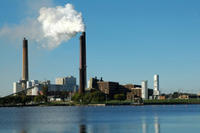-
Napolitano testifies on cybersecurity executive order
Two Senate panels questioned DHS Secretary Janet Napolitano yesterday at a hearing on President Obama’s cybersecurity executive order and what issues need to be addressed in cyber legislation. “We simply cannot afford to wait any longer to adequately protect ourselves,” Said Senator Jay Rockefeller (D-West Virginia), chairman of the Senate Commerce Committee.
-
-
Tech companies, telecoms clash over cybersecurity executive order
Last August a cybersecurity bill died in Congress amid partisan bickering. On 12 February this year, President Obama packed many of that bill’s elements into a cybersecurity executive order. To make the order more acceptable to some of its congressional and industry critics, the president introduced an exemption which would take large technology companies off the list of companies subject to the new cybersecurity standards. This exemption placated some of the original cybersecurity bill’s critics, but angered others, chief among them telecommunication companies.
-
-
Precious metal recovery technique ideal for rare Earth elements purification
Researchers have come up with a new approach to make the recovery of high value precious metals faster and more economically viable. The new technique could be ideal for the purification of rare earth elements, which are vital commodities for ‘green’ technologies such as hybrid cars and novel batteries.
-
-
Coal and U.S electric power generation

Coal is an important fuel source in the United States today. Responsible for approximately 39 percent of the country’s electrical generation, coal is vital to the day-to-day operation of people’s lives. The United States is rich in coal deposits, with large resources. One of the most important and largest of those deposits is found in the Powder River Basin (PRB) of Wyoming and Montana, which, in 2012, produced more than 42 percent of the nation’s coal.
-
-
U.S. nuclear industry resists stricter, post-Fukushima safety measures
Since the March 2011 Fukushima disaster, members of the Nuclear Regulatory Commission (NRC) have been debating whether or not to impose even stricter safety measures on the thirty-one U.S. boiling water reactors (BWRs). Utility companies have been fighting any new safety regulations, arguing that the security measures they have are more than enough.
-
-
New source for rare earth elements: discarded consumer products
In a new twist on the state’s mining history, a group of Idaho scientists will soon be crushing consumer electronics rather than rocks in a quest to recover precious materials. Two national labs in the state will apply expertise gained in recycling fissionable material from nuclear fuel to separate rare earth metals and other critical materials from crushed consumer products.
-
-
Using plants for herbal defluoridation of drinking water

A filtration system based on a medicinal herb can quickly and easily remove “fluoride” from drinking water, say researchers in India. The technology uses parts of the plant Tridax procumbens as a biocarbon filter for the ion.
-
-
Does the U.S. face a nuclear power exit?
In a 2012 report, the Obama administration announced that it was “jumpstarting” the U.S. nuclear industry. Because of the industry’s history of problems, cost overruns, and construction delays, financial markets have been wary of backing new nuclear construction for decades. The supposed “nuclear renaissance” proclaimed in the first decade of this century never materialized. Then came Fukushima, a disaster that prompted countries around the world to ask: Should nuclear power be part of the energy future?
-
-
Norfolk, Virginia, tries to cope with sea-level rise
Norfolk, Virginia, is home to the largest U.S. naval base in the country, and the second biggest commercial port on the U.S. Atlantic coast. Floods are an ever-present problem, a problem which has become worse in recent decades. The relative sea level around Norfolk has risen 14.5 inches (.37 meter) since 1930, when the low-lying downtown area routinely flooded. The frequency of storms-induced surges has increased as well.
-
-
The impact of sea-level rise on coastal military installations
The Pentagon says that climate-related effects are already being observed at Department of Defense (DoD) installations in every region of the United States and its coastal waters. The effects of climate change will adversely impact military readiness and DoD natural and built infrastructure unless these risks are considered in DoD decisions. A new white paper developed by the Pentagon’s Strategic Environmental Research and Development Program (SERDP) identifies key climate-related policy questions that need to be addressed.
-
-
Volcanic aerosols, not pollutants, slowed recent Earth warming
Researchers looking for clues about why Earth did not warm as much as scientists expected between 2000 and 2010 now thinks the culprits are hiding in plain sight — dozens of volcanoes spewing sulfur dioxide.
-
-
RFI for cybersecurity framework for critical infrastructure
In his 12 February 2013 Executive Order, President Obama called for the development of a Cybersecurity Framework to reduce cyber risks to critical infrastructure such as power plants and financial, transportation, and communications systems. The National Institute of Standards and Technology (NIST) the other day issued a Request for Information (RFI) in the Federal Register as its first step in the process to developing that framework.
-
-
No gloom-and-doom: science does not back global tipping point view
A group of international ecological scientists have rejected a doomsday-like scenario of sudden, irreversible change to the Earth’s ecology. The scientists argue that global-scale ecological tipping points are unlikely and that ecological change over large areas seem to follow a more gradual, smooth pattern.
-
-
New power engineering curriculum to help U.S. security, economy
Nearly 40 percent of all energy consumed in the United States is first converted to electricity, with that figure expected to rise to as much as 70 percent in the future. Increasing the pipeline of graduates in electric power and energy has implications for both the country’s place in the global market and national defense. The more expertise there is at home, the less the United States will have to import talent and energy resources from overseas. An Office of Naval Research (ONR)-supported project is bringing sweeping changes to electric power and energy education at universities throughout the country, establishing first-time programs at some schools and bringing new courses and labs to others.
-
-
Modified bacteria turn bio waste into fat for fuel

“Green” chemistry developed at Rice University is at the center of a new government effort to turn plant waste into fatty acids and then into fuel. A new project aims to develop a new generation of renewable energy and bio-based products from switchgrass and forestry residues and from a new hybrid of sorghum.
-
More headlines
The long view
Helping Strengthen America’s Critical Infrastructure
Everyday life depends on a robust infrastructure network that provides access to running water, communications technology and electricity, among other basic necessities. The experts who keep our national infrastructure secure and resilient also need a strong network to share their knowledge and train the next generation of professionals capable of solving complex infrastructure challenges.
AI and the Future of the U.S. Electric Grid
Despite its age, the U.S. electric grid remains one of the great workhorses of modern life. Whether it can maintain that performance over the next few years may determine how well the U.S. competes in an AI-driven world.
Using Liquid Air for Grid-Scale Energy Storage
New research finds liquid air energy storage could be the lowest-cost option for ensuring a continuous power supply on a future grid dominated by carbon-free but intermittent sources of electricity.
Enhanced Geothermal Systems: A Promising Source of Round-the-Clock Energy
With its capacity to provide 24/7 power, many are warming up to the prospect of geothermal energy. Scientists are currently working to advance human-made reservoirs in Earth’s deep subsurface to stimulate the activity that exists within natural geothermal systems.
Experts Discuss Geothermal Potential
Geothermal energy harnesses the heat from within Earth—the term comes from the Greek words geo (earth) and therme (heat). It is an energy source that has the potential to power all our energy needs for billions of years.
